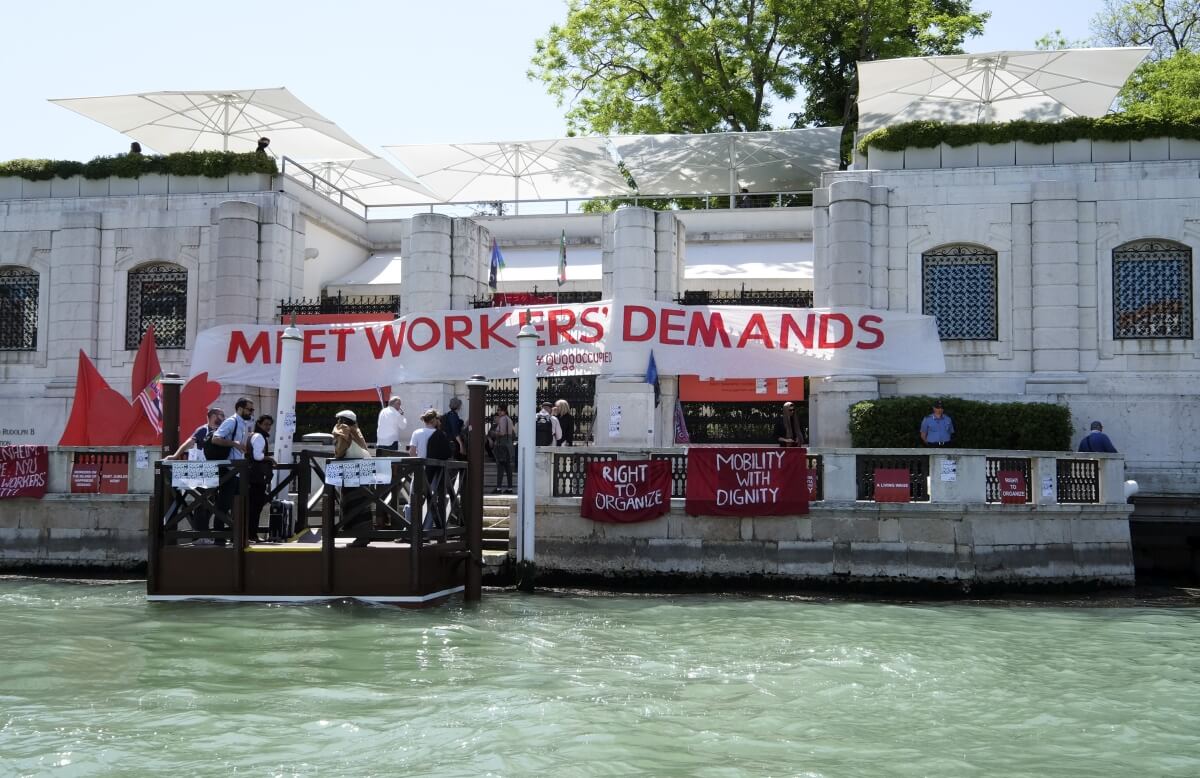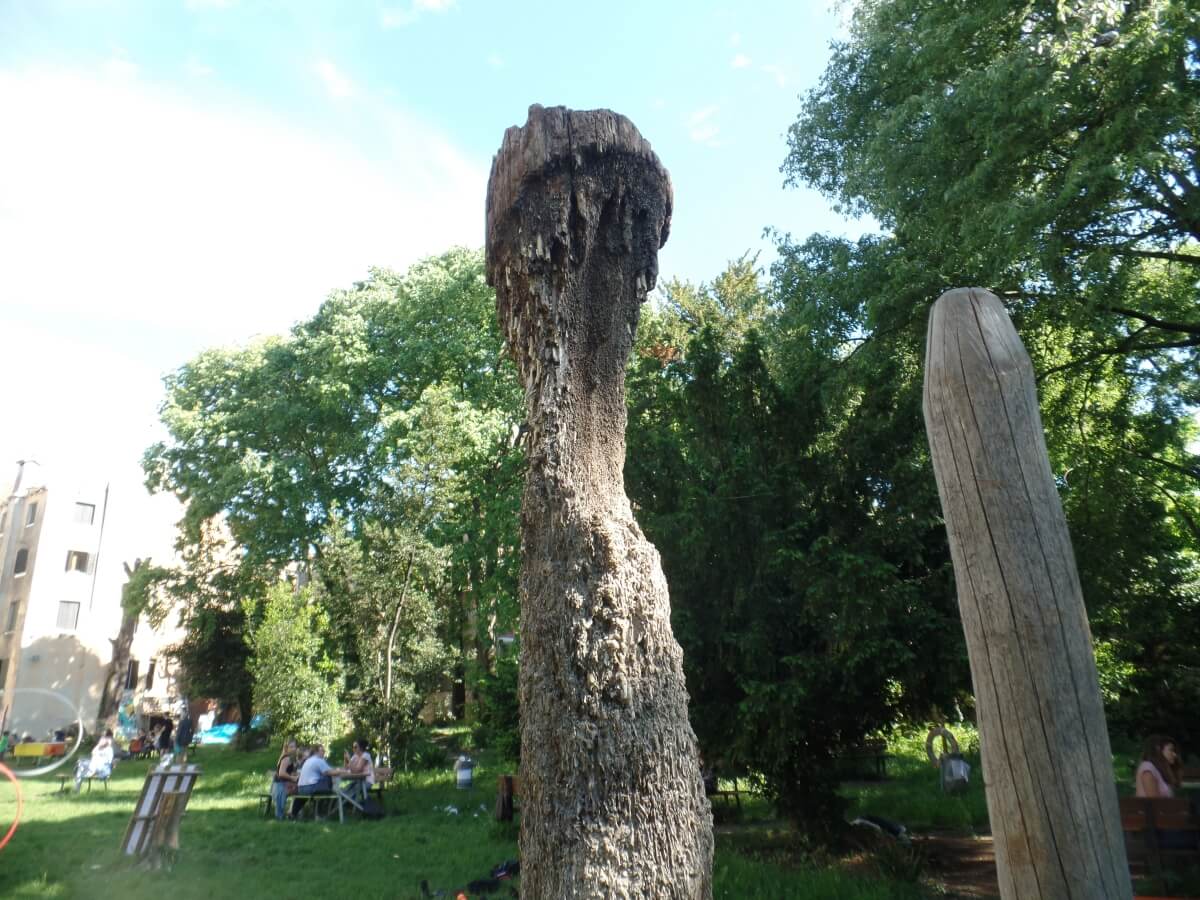Venice, Italy is not the first place that comes to mind when the phrase rebel cities is invoked. More likely associations include vacation capital of Europe, or home of the world’s oldest global art biennial. Nonetheless, a flourishing, independent cultural scene exists around the margins of the tourist-choked city, its network operating in locations that most visitors and art world audiences never visit, or simply overlook. Chief among these self-organized cultural spaces is S.a.L.E Docks on the Fondamenta delle Zattere at the tip of Dorsoduro. Not far away is the Garden of Ca’ Bembo, a small, verdant park that students from the University of Venice have occupied since 2014.
Across the canal, a block called “Casette”, on the island of Giudecca, hosts the ASC, a Social Assembly For Housing that organizes the occupation of empty public apartments in a city where real estate price is out of control, and where the flight of inhabitants is a plague. Another popular neighborhood, Castello, is home to Morion, the oldest autonomous squat in town, participants trade shifts making pizza and serving drinks while the space hosts live music and is one of the activist engines of the struggle against big cruise ships (more about this below). S.a.L.E Docks’ network expands beyond Venice too, the Milan based art-activist collective of Macao, for example, appears as one of its regular collaborators.
As Marco Baravalle, a co-founder of S.a.L.E Docks puts it, these spaces were founded through the squatted occupation of unused buildings, often by the very same “creatives” that Venice seeks to attract as its entrepreneurial workforce. As we know from other global cities, armies of artists, designers, architects and university students serve to reproduce the creative city paradigm through precarious labor including unpaid internships. But in 2007 a group of far more politicized cultural workers gathered together, determined to rebel. They decided to squat one of the city’s nine large and unused salt warehouses. As Baravalle explains:
“the idea of occupying a space in town came after a collective analysis of a transition of the productive model that affected the city and became quite visible at the half of the first decade of the millennium. We described it as a shift from the ‘museum city’ or the ‘città d’arte’ to the ‘creative city’ or the ‘city of the contemporary.”
A shift from the ‘museum city’ or the ‘città d’arte’ to the ‘creative city’ or the ‘city of the contemporary.’
Baravalle points out that Venice, unlike London or Berlin, is not fully running off of its creative economy. Instead, what local creatives generate is symbolic capital necessary for a city that primarily profits from its fabled association with Western high-culture. Perhaps the most conspicuous and unsettling evidence of this link between capitalizing one’s historical treasures and modern municipal financial interests is the startling presence of 96,000 ton cruise ships navigating through the city’s Giudecca Canal and crammed full of tourists. Not only do these bloated party boats damage the fragile ecosystem of canals and lagoon, they amplify the human presence in this relatively small city so that while Venice now has only 54,000 actual residents, the annual tourist population explodes to 30 million, a number that is more than 500 times larger. The S.a.L.E Docks collective and its network of participants have engaged in direct protest action against these ships, even on one occasion attempting to block their passage with a rag-tag flotilla of small craft, inflatables and home-made rafts.
Significantly, S.a.L.E Docks does not delude itself regarding the interwoven cultural economy of the city. On the contrary, inside the cave-like 14th Century warehouse the group has constructed a series of temporary exhibitions, a woodshop, bar and meeting space by imaginatively repurposing left-over materials recycled from the Venice Biennial itself. Indeed, in a city such as Venice, it would be virtually impossible for a culturally oriented project to imagine itself fully autonomous from the art world: what matters is the nature of that relationship. As Baravalle comments, “these very contradictions represent S.a.L.E Docks field of intervention.”
What matters is the nature of the relationship between culturally oriented project and the art world.
S.a.L.E is only a short stroll from such mainstream Venetian art attractions as Gallerie dell’Accademia and the Peggy Guggenheim Collection. Still, S.a.L.E’s very presence defies neoliberal models of the so-called creative city in so far as the space and its supporters maintain a critical distance from the city’s cultural tourism. But when the global art world descends on Venice every two years it simply represents too big a target to ignore. At the opening of the 56th Biennale in May of 2015 S.a.L.E joined forces with a faction of the Gulf Labor group in order to stage a marine landing and occupation of the Guggenheim facility. The allied operation aimed to pressure the museum’s corporate board of directors in New York to guarantee decent working conditions and fair wages for immigrant laborers building the new Guggenheim on Saadiyat Island in Abu Dhabi, United Arab Emirates.

This spring S.a.L.E worked in collaboration with Warsaw-based theorist Kuba Szreder to launch a different type of art world critique to coincide with the 57th Biennale. The project known as Dark Matter Games (DMG) is “a living collection of creative surplus flourishing beyond, across, and underneath the art industry.” That “surplus” consisted of “antifascist struggles, gender rights demos, anti-gentrification occupations, fair labor campaigns, environmental justice projects, racial, sexual and indigenous peoples’ interventions and all such strategies for equality.” In other words, DMG seeks to map just about everything that the official Biennale does not, and likely never will.
The multi-million Euro operation would have to fundamentally invert itself in order to truly confront the inherent 1% aesthetic.
Yes, it is true that curator Okui Enwezor pushed the envelope as far as possible these days with his 56th Venice Biennial “All the World’s Futures,” even inviting Gulf Labor to his program. And yes, this year the 57th exhibition presents works Rashed Araeen, Bonnie Ora Sherk, and The Play amongst other previously overlooked artists and artists’ groups. Ultimately, however, the multi-million Euro operation that attracts the world’s top gallerists, collectors, curators, auctioneers and museum directors along with representatives of the global super-wealth would have to fundamentally invert itself in order to truly confront the inherent 1% aesthetic that grounds the very logic of the Venice Biennial and similar high-cultural extravaganzas.
Now, in full disclosure, S.a.L.E Docks’ DMG project draws directly upon my own writings (and I was also compensated as a consultant on the project). Still, my involvement is not what is key to this report, which focuses on the remarkable survival of culturally critical practices within the very heart of the “city of the contemporary.” Nor is S.a.L.E alone in this campaign. At the nearby Garden of Ca’Bembo several artists organized a sort of mock art pavilion that honors Native Americans, a group, or perhaps nation with no official presence in the official Biennial. Zuecca Projects, a local non-profit, artists Oscar Tuazon and Nicholas Galanin constructed a Longhouse of the type indigenous tribes have built for centuries in the Pacific Northwest region of America. Built from oak posts salvaged out of the lagoon the work also pays tribute to the Standing Rock Water Protectors in North Dakota who have so far successfully prevented an oil pipeline from being located on their land. Artist Tuazon even participated in these pro-environmental protests across the pond.

The link is obvious between the Native American struggle over land and water rights, and the battle to save Venice from its own creative economy imaginary, with the processes of repurposing material at the center of that endeavor. And the goal? As Baravalle asserts, we need to build “a critical participation, a model of working collectively that [is] free and horizontal and at the same time not neutral, concretely in contrast and alternative to the neoliberal model of the art institutions of the city.” For at the end of the day, it’s not capital’s idea of a creative city that we are in desperate need to establish. And yet the components needed for our counter-paradigm will need to be actively recycled out of existing realities. S.a.L.E Docks and its network of independent Venetian cultural spaces embody a powerful and expandable prototype for this urgent project.
![Political Critique [DISCONTINUED]](https://politicalcritique.org/wp-content/uploads/2015/09/Political-Critique-LOGO.png)
![Political Critique [DISCONTINUED]](https://politicalcritique.org/wp-content/uploads/2015/09/Political-Critique-LOGO-2.png)